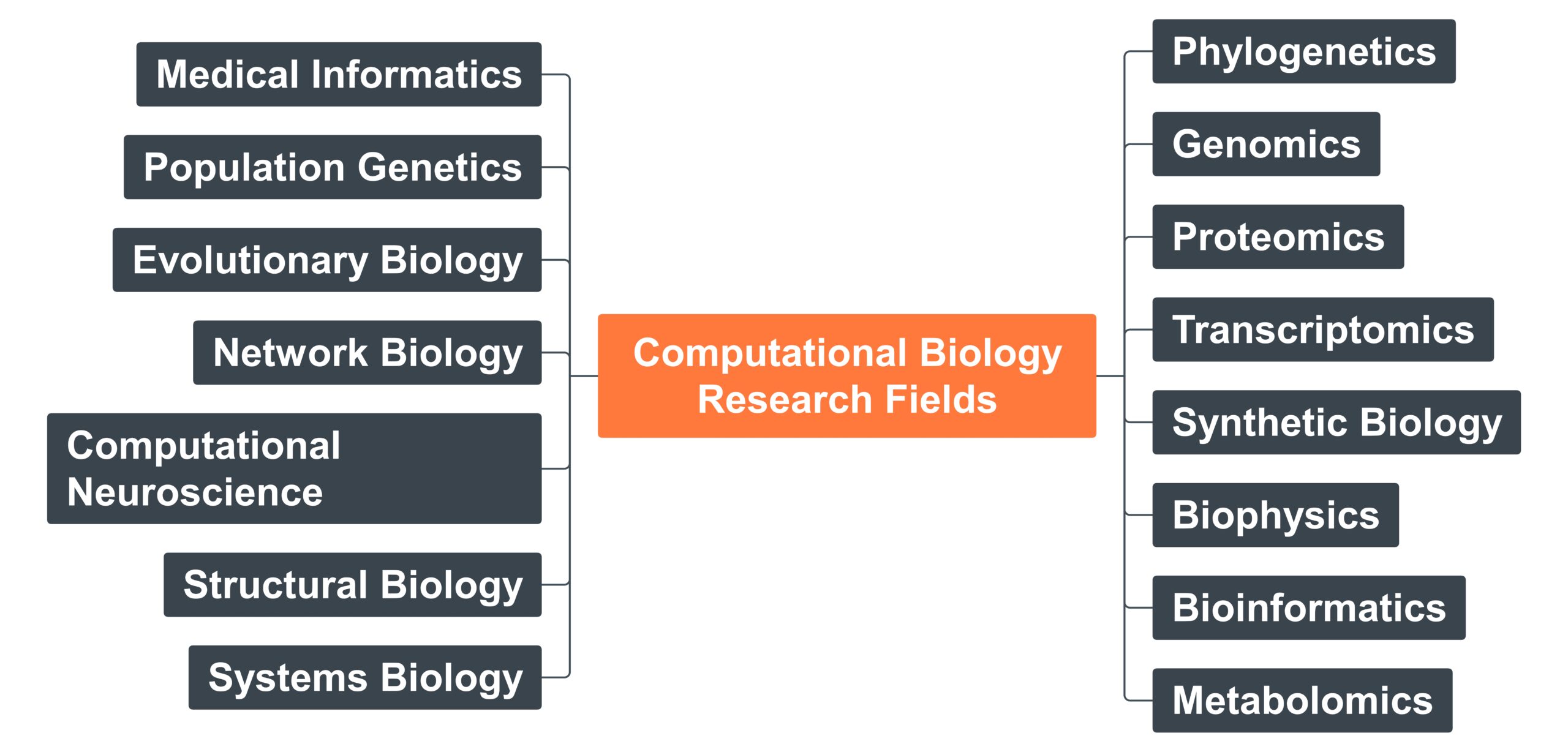Bioinformatics vs Computational Biology
Computational biology and bioinformatics are among the most exciting fields in modern biology. They both offer useful tools and vital information for biological research. Though closely related, they have different goals, procedures, and outcomes. This article highlights each field and what each offers to help students or professionals appreciate the contributions in advancing our understanding of current biology.
Table of Contents
What is Bioinformatics?
Bioinformatics involves using computer tools to study big sets of biological information. This information includes things like DNA patterns, protein shapes, and medical details. The goal is to find connections and patterns in the data.
Applications in Research
Bioinformatics is very important in many different types of research, including:
- Genomics: Examines all the genes in a person’s body to identify variations in DNA that could lead to diseases. This method is used in research that analyzes numerous genes simultaneously to determine if they are linked to specific diseases and to discover gene alterations that are hereditary.
- Proteomics: Concentrates on learning about the shapes and roles of proteins in cell activities. It aids in creating a complete list of proteins (called the proteome) that a genome, cell, tissue, or organism produces.
- Pharmacogenomics: Uses information from a person’s genes to create special medical treatments just for them. This area adjusts medicines based on each person’s unique genes to work better and cause fewer bad reactions.
- Clinical Informatics: Handles and examines patient information to boost medical results. Combines data from digital health records and uses forecasting techniques to better patient treatment.
LAST BIOINFORMATICS INTERNSHIP OF THE YEAR STARTS TODAY
Tools and Techniques
Key tools and techniques in bioinformatics include:
- Sequence Alignment Algorithms: Look at DNA or protein sequences side by side to see how alike or different they are. Tools like BLAST and ClustalW can help with this.
- Machine Learning Algorithms: Helps predict biological outcomes by analyzing large amounts of data. Techniques like neural networks and support vector machines (SVM) assist in organizing and forecasting events.
- Network Analysis Tools: Look at images and learn about how parts of living things, such as proteins, touch one another. Commonly, people use software like Cytoscape and Gephi for this purpose.

What is Computational Biology?
Definition and Scope
Computational biology encompasses bioinformatics but extends to include computational modeling and simulation of biological systems. This field uses mathematical models and computer simulations to study complex biological processes that are often too intricate to be analyzed experimentally.
Applications in Research –Bioinformatics vs Computational Biology
Computational biology is important for understanding and simulating biological systems that are just too complex to be addressed experimentally. The principal applications in this field include:
- Molecular Dynamics: Simulating the physical movements of atoms and molecules. It provides insights into the dynamic behavior of biomolecules, essential for drug design and understanding biochemical pathways.
- Systems Biology: Modeling and simulating entire biological systems to understand their behavior. It integrates data from various sources to build comprehensive models of cellular processes.
- Synthetic Biology: Designing and creating new biological parts and systems. Computational tools aid in constructing synthetic genetic circuits and optimizing metabolic pathways.
Tools and Techniques
The tools and techniques of computational biology include:
- Molecular Dynamics Simulations(MDS): Molecular dynamics simulations (MDS) explore atomic-level interactions and movement in biomolecules over time. This method provides detailed insights into protein folding, enzyme mechanisms, and drug interactions, making it invaluable for drug design and understanding biochemical pathways.
- Agent-Based Modeling: It is the modeling of a system by simulating its individual agents’ behaviors, such as cells. This technique considers each entity within a system interacting with others to explain complex behaviors.
- Monte Carlo Simulations: Monte Carlo simulations involve probabilistic modeling and random sampling techniques to study complex systems. They are used in computational biology to explore the thermodynamic properties of biological molecules, optimize algorithms, and perform Bayesian inference.

Main Differences Between Bioinformatics and Computational Biology
The chief differentiation between bioinformatics and computational biology thus rests on what they focus on.
- Bioinformatics: Involves the study and understanding of large biological information sets. It could be singled out, with the development of methods and software for managing and analyzing data produced through bio-research.
- Computational Biology: A study of using mathematical models and computer simulations to get into the research of biological systems. It wishes to explain how the biological processes exactly happen with the help of these computational models.
| Aspect | Bioinformatics | Computational Biology |
|---|---|---|
| Definition | Application of computational tools and techniques to manage, analyze, and interpret biological data. | The development and use of mathematical and computational models to understand biological systems. |
| Focus | Data-driven, focusing on the management, storage, and analysis of biological data. | Hypothesis-driven, focusing on understanding biological systems and phenomena. |
| Scope | Includes sequence analysis, data mining, and database creation for biological data. | Includes modeling biological processes, systems biology, and simulations. |
| Key Areas | Genomics, proteomics, transcriptomics, and database management. | Systems biology, evolutionary biology, and quantitative modeling. |
| Tools and Techniques | Focuses on bioinformatics tools like BLAST, FASTA, and bioinformatics software. | Employs statistical models, algorithms, and simulation tools. |
| Primary Outputs | Analysis results, such as sequence alignments, functional annotations, and structural predictions. | Insights into biological mechanisms, dynamics, and predictions of behavior under various conditions. |
| Interdisciplinary Link | Combines biology with information technology and data science. | Combines biology with mathematics, physics, and computational science. |
| Examples of Work | Creating databases for storing genetic data or analyzing gene expression data. | Building models of cellular processes or simulating evolutionary pathways. |
| End Goals | Efficiently handle and analyze large datasets from biological research. | Derive mechanistic insights and predict biological phenomena. |
| Skillset Required | Programming, data analysis, and database management. | Mathematical modeling, algorithm design, and systems analysis. |
| Practical Applications | Identifying gene functions, drug target discovery, and personalized medicine. | Predicting disease mechanisms, modeling biological systems, and synthetic biology. |
Table: Difference between Bioinformatics & Computational Biology
Tools and Platforms
- Bioinformatics Tools: Focus on analyzing bioinformatic data using methods like sequence alignment and network analysis. Tools like BLAST and Cytoscape are tailored to manage and interpret biological data efficiently.
- Computational Biology Tools: These tools simulate biological systems and processes, aiding in predicting and understanding molecular and cellular functions. For instance, molecular dynamics tools like GROMACS help study biomolecular interactions, while agent-based modeling tools simulate the behavior of individual system components, such as cells.
Interdisciplinary Nature
Both fields are highly interdisciplinary, but they draw expertise from different areas:
- Bioinformatics: Usually includes knowledge from computer science, statistics, and biology. It needs abilities in coding, managing data, and analyzing statistics to work with biological information.
- Computational Biology: Requires skills in math, physics, and biology. It involves using ideas and computer techniques to solve issues in living things.
Convergence in Modern Research
SaaS Platforms
Recent enhancements to software-as-a-service or SaaS have brought bioinformatics and computational biology closer. For example, platforms like DNAnexus combine sequencing analysis with modeling workflows, enabling researchers to seamlessly transition between analyzing large datasets and building biological models.
Bioinformatics vs Computational Biology
Implementing Software Tools
Modern software as a service (SaaS) platforms frequently combine tools from both data analysis and modeling, making it easy for researchers to switch between these tasks. This combination is speeding up discoveries in many areas of biology by offering complete solutions for examining intricate biological systems.
Differences Summarized
- Aim: While bioinformatics is targeted at the analysis of biological data obtained in experiments, computational biology is focused on basic processes, modeling, and simulation.
- Tools: Bioinformatics involves comparing sequences and analyzing networks, whereas Computational Biology focuses on the study of the movement of molecules by modeling individual agents. Again, depending on the particular objectives and used techniques, each area will use different tools.
- Applications: One of the focuses of bioinformatics is genomics and pharmacogenomics, while computational biology, it is systems and synthetic biology. Both use their specific tools to study a wide array of biological questions and problems.
- Interdisciplinary Expertise: Bioinformatics combines computer science, biology, and statistics. Skills like coding, statistical analysis, and data management are essential. Whereas Merges biology with mathematics and physics, focusing on mathematical modeling and computer-based simulations. However, both fields increasingly use shared methods, such as machine learning and statistical techniques, to advance research.
- Level of Abstraction: Bioinformatics primarily focuses on analyzing real-world biological datasets, such as DNA sequences and proteomics data. Computational biology, while also using real-world data, applies this information to create and validate mathematical models for simulating hypothetical scenarios and testing biological hypotheses.
- Research: Bioinformatics deals with existing data. Computational Biology makes use of computers in the pursuit of new ideas. Here, bioinformatics helps in giving meaning to data, and computational biology helps in the formation of newer hypotheses and explanations by using computer simulations.
The two categories that go hand in hand in helping to unravel the mysteries of life are computational biology and bioinformatics. While this involves a bulk of analysis of biological data for patterns and key information, it is computational biology studies that build complex models showing how living systems work. Therefore, these fields will, when combined, give students and professionals new and very important realizations that will enable them in their research and careers in the ever-changing world of modern biology.
LAST BIOINFORMATICS INTERNSHIP OF THE YEAR STARTS TODAY
Final Call for Bioinformatics Global Research Tools & Techniques OFFLINE / ONLINE Hands-on Training cum Internship With Project / Dissertation
NOW AVAILABLE IN OFFLINE MODE AS WELL
GET 1 Year of Research Experience
STARTS 25th NOV 2024 ✔️
PUBLISH PAPERS | WORK IN PROJECTS | GET WORK EXPERIENCE LETTER








































